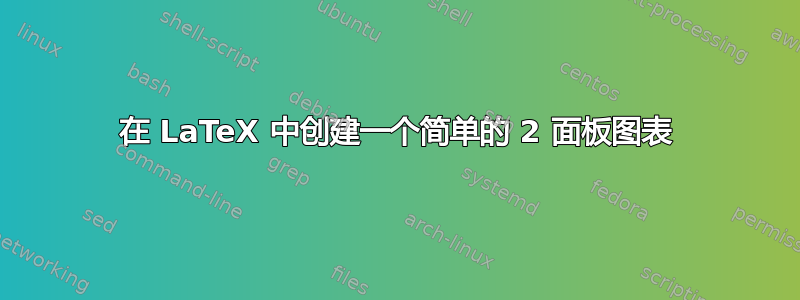
我正在尝试用 LaTeX 制作双面板图表。我不知道它会有多复杂。有人能建议创建此类图表的起点是什么吗?
图表如下:

我将非常感激您的任何建议。
答案1

CAD包中的模块可以Asymptote提供帮助。下面
p.tex将生成一个panel.asy文件,其中包含类(结构)的简要概述Panel,它具有简单的结构,如果需要,可以轻松进一步定制。有关operator init详细信息,请参阅。
\begin{filecontents*}{panel.asy}
import CAD;
struct Panel{
real Tc, QpR, D;
real blockHeight, blockTop;
int nSections;
real xtipSize,ytipSize;
sCAD cad;
void drawGraph(){
draw(g=(0,0)*cm--(Tc,QpR)*cm--(D,QpR)*cm--(D+Tc,0)*cm,cad.pA);
draw(g=(D+Tc,0)*cm--(D+Tc,QpR)*cm,cad.pB);
cad.MeasureParallel(L = "$Q_{pR}$",
pFrom = (Tc, 0)*cm,
pTo = (Tc, QpR)*cm,
dblDistance = 0mm);
cad.MeasureParallel(L = "$T_{c}$",
pFrom = (0, QpR)*cm,
pTo = (Tc, QpR)*cm,
dblDistance = 2mm);
cad.MeasureParallel(L = "$T_{c}$",
pFrom = (D, QpR)*cm,
pTo = (D+Tc, QpR)*cm,
dblDistance = 2mm);
}
void drawBlock(){
real dx=D/nSections;
for(int i=1;i<nSections;++i){
draw(((i*dx, blockTop-blockHeight)*cm--(i*dx, blockTop)*cm),cad.pB);
}
draw(box((0, blockTop-blockHeight)*cm, (D, blockTop)*cm),cad.pA);
cad.MeasureParallel(L = "$D$",
pFrom = (0, blockTop)*cm,
pTo = (D, blockTop)*cm,
dblDistance = 2mm);
}
void drawAxes(){
draw((0,0)*cm--(D+Tc+xtipSize,0)*cm,cad.pB,Arrow(HookHead,size=1mm));
draw((0,0)*cm--(0,blockTop+1+ytipSize)*cm,cad.pB,Arrow(HookHead,size=1mm));
}
void drawYLabel(){
label(rotate(90)*Label("Discharges (cms)")
,0.5(0,blockTop+1+ytipSize)*cm
,W);
}
void operator init(real Tc, real QpR, real D=Tc
, real blockHeight=0.5, real blockTop=1.5QpR, int nSections=10
,real xtipSize=0.5, real ytipSize=xtipSize){
this.Tc=Tc;
this.QpR=QpR;
this.D=D;
this.blockHeight=blockHeight;
this.blockTop=blockTop;
this.nSections=nSections;
this.xtipSize=xtipSize;
this.ytipSize=ytipSize;
this.cad = sCAD.Create();
drawGraph();
drawBlock();
drawAxes();
drawYLabel();
}
}
\end{filecontents*}
%
%
\documentclass[10pt,a4paper]{article}
\usepackage{lmodern}
\usepackage{subcaption}
\usepackage[inline]{asymptote}
\usepackage[left=2cm,right=2cm,top=2cm,bottom=2cm]{geometry}
%
\begin{document}
%
\begin{figure}
\captionsetup[subfigure]{justification=centering}
\centering
\begin{subfigure}{0.49\textwidth}
\begin{asy}
size(7cm);
import panel;
defaultpen(fontsize(10pt));
Panel pan=Panel(3, 4,nSections=11);
\end{asy}
%
\caption{$D=T_c$}
\label{fig:1a}
\end{subfigure}
%
\begin{subfigure}{0.49\textwidth}
\begin{asy}
size(8cm);
import panel;
defaultpen(fontsize(10pt));
Panel pan=Panel(2, 5,D=6,nSections=15);
\end{asy}
%
\caption{$D>T_c$}
\label{fig:1b}
\end{subfigure}
\end{figure}
%
\end{document}
为了处理它latexmk,请创建文件latexmkrc:
sub asy {return system("asy '$_[0]'");}
add_cus_dep("asy","eps",0,"asy");
add_cus_dep("asy","pdf",0,"asy");
add_cus_dep("asy","tex",0,"asy");
然后运行latexmk -pdf p.tex。
答案2
以下是使用 TikZ 的可能性;定义了一些辅助命令来自动绘制图表的某些元素(见下面的解释):
\documentclass{article}
\usepackage{tikz}
\usetikzlibrary{chains,arrows}
\newcommand\textarrow[3]{%
\draw[<->,] #1 -- node[fill=white] {$\scriptstyle #3$} #2;}
\newcommand\myrect[3]{%
\begin{scope}[
yshift=#2,
start chain,
every node/.style={on chain,inner sep=0pt,text width=2mm},
node distance=-\pgflinewidth,anchor=west
]
\foreach \mvalue in {1,...,\the\numexpr#1*5\relax}
\node[draw,text height=14pt] {};
\end{scope}
\draw[<->]
([yshift=#2+19pt]0,0) --
node[fill=white] {$\scriptstyle#3$}
([yshift=#2+19pt]#1,0);
\draw ([yshift=#2+9pt]#1,0) -- +(0,15pt);
}
\newcommand\axes[2]{%
\draw[->] (0,0) -- +(0,#1);
\draw[->] (0,0) -- +(#2,0);
}
\begin{document}
\begin{tikzpicture}[>=latex]
\axes{7}{7}
\draw (0,0) -- (3,4) -- (6,0);
\textarrow{(3,0)}{(3,4)}{Q_pR}
\textarrow{(0,-12pt)}{(3,-12pt)}{r_c}
\textarrow{(3,-12pt)}{(6,-12pt)}{r_c}
\foreach \xcoor in {0,3,6}
\draw (\xcoor,-2pt) -- +(0,-15pt);
\myrect{3}{5.25cm}{D-T_c}
\node[rotate=90,anchor=south,font=\small] at (0,3) {Discharge (cms)};
\node[anchor=east,font=\small] at (0,5.2) {(A)};
\end{tikzpicture}
\vspace{1cm}
\begin{tikzpicture}[>=latex]
\axes{7}{9}
\draw (0,0) -- (2,4) -- (6,4) -- (8,0);
\textarrow{(2,0)}{(2,4)}{Q_pR}
\textarrow{(0,4cm+12pt)}{(2,4cm+12pt)}{r_c}
\textarrow{(6,4cm+12pt)}{(8,4cm+12pt)}{r_c}
\foreach \xcoor in {2,6}
\draw (\xcoor,4cm+2pt) -- +(0,15pt);
\draw (8,0) -- +(0,4cm+17pt);
\myrect{6}{5.5cm}{D}
\node[rotate=90,anchor=south,font=\small] at (0,3) {Discharge (cms)};
\node[anchor=east,font=\small] at (0,5.5) {(B)};
\end{tikzpicture}
\end{document}

辅助命令包括:
\axes{<length1>}{<length2>}
绘制两个垂直轴:从(0,0)到(0,<lenght1>)以及从(0,0)到(<length2>,0)。
\myrect{<value>}{<length>}{<text>}
(0,<length>)绘制从 开始向右延伸距离 的阴影矩形<value>;它还会在矩形顶部中间放置一个箭头<text>。在其当前形式中,<value>必须为正整数。
最后,第三条命令
\textarrow{<pos1>}{<pos2>}{<text>}
<pos1>在和之间画一条线,<pos2>两端有箭头,<text>中间有 。例如,
\begin{tikzpicture}[>=latex]
\axes{5}{12}
\myrect{3}{3cm}{a}
\myrect{6}{1cm}{b}
\end{tikzpicture}
生产

和
\begin{tikzpicture}[>=latex]
\textarrow{(3.5,0)}{(3.5,3)}{a}
\textarrow{(0,0)}{(3,0)}{b}
\textarrow{(4,0)}{(6,3)}{c}
\end{tikzpicture}
生产



